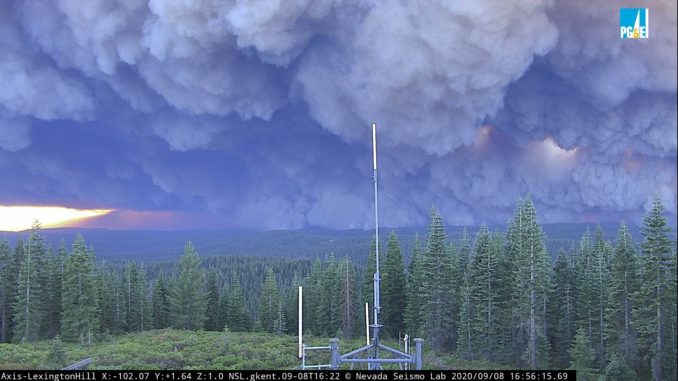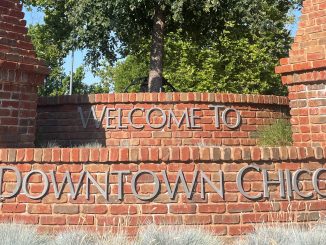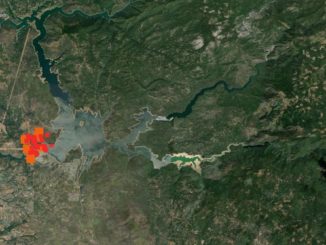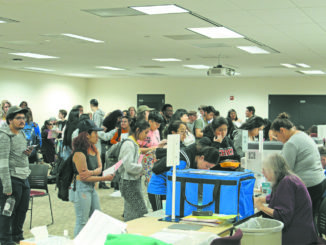
For the better part of the 21st century, Mark Stemen has immersed himself in the science of climate change and planning responses. He’s spoken often—to his Geography Department students at Chico State, government leaders and the public at civic meetings—about impacts as broad as weather patterns and specific as the fruit yield of cherry trees. Poring over global-warming models, he’s shared forecasts for years, even decades, ahead.
As a member of what was then the city’s Sustainability Task Force, which morphed into the Climate Action Commission, Stemen worked on Chico’s climate action plan, which the City Council adopted in 2014. That document set out targets for reducing greenhouse gas emissions to meet state requirements by 2020. Butte County completed a parallel process, with the Board of Supervisors approving a countywide CAP the same year.
Forecasting is one thing. Experience is another. As both the city and county now work through updates to their respective CAPs, climate action has hit discomfitingly close to home.
“In 2005 we were talking about problems; in 2020, we’ve lived through them,” Stemen, who vice-chairs the city’s climate commission, told the CN&R. “We are a front-line community, and it had really colored and influenced this next round. This isn’t speculation any more.”

Dan Breedon, the county’s Planning Division manager and point person for its CAP update, concurs.
“What’s happened in Butte County the last five years—the major incident with the Oroville Dam Spillway, then the progression of greater and greater wildfires that we’ve had, starting even before the Camp Fire with fires that were formidable—you can’t ignore the climate change implications of what’s taking place,” he said by phone.
Climate action plans focus on emissions of greenhouse gases, or GHGs, as opposed to impact conditions (such as weather, water levels and wildfires) that the city and county cover in companion plans known as climate vulnerability assessments. This is because the state calls for a CAP to delineate how the municipality will contribute to California’s GHG goals.
The 2020 milestone was a reduction to match 1990 emissions levels. The next goal is a 40 percent reduction from 1990 levels by 2030, and the final mark is 80 percent from 1990 levels by 2050.
Breedon told the CN&R that the county still is compiling its emissions data for the update but will have it finalized and up on its CAP update site for public review in the next couple weeks.
The city is about a half-year ahead of the county in its process; it has reviewed data. At the March 11 meeting, climate commissioners discussed the outline of Chico’s CAP update, which a consultant is preparing. The draft should come to the commission and the public in June, Stemen said, then the final version to the City Council in August.
The county’s plan, Breedon said, should go to the Board of Supervisors in December.
What’s different
While county planners continue to crunch numbers, Stemen has seen enough big-picture information from the state sources that both Chico and Butte County draw upon to give a status report. Chico met its target of reducing GHG emissions 25 percent (doing so 27 percent), while the county fell short of its reduction target of 15 percent (cutting emissions 13 percent).
Half of the county’s emissions come from agriculture, Stemen said, with about 30 percent from transportation and 10 percent from energy—while the bulk of Chico’s emissions trace to transportation (60 percent) and energy (34 percent).
“There’s differences on what’s going to be the most important things and what’s going to be the biggest hurdles for each,” Stemen added, but noted that the city and county are not polar opposites. On energy use, for instance, both could accomplish the same goal through community choice aggregation of electricity, in which the municipality breaks from a utility company such as Pacific Gas & Electric and sets up power distribution under which it can ensure the source’s carbon-neutrality.
“That’s a clear one where the city and county are walking hand in hand,” he continued. “So, some issues, hardly related at all. Some we need to figure out how to work on—transportation. Others, we’ve got pretty well figured out.”

The latter includes construction. The state already requires solar panels on roofs of new homes; Chico’s CAP update proposes no natural gas lines in new development, to further reduce the draw on fossil fuels. Such a change targets a key source of emissions in an urban area.
“The flip side,” Stemen said, “is the county has an enormous opportunity to mitigate its own emissions in agriculture. Carbon farming, carbon sinks, regenerative ag—there is no real counterpart in the city. We can plant some trees, we have some open space we can manage differently, but there is no sequestration opportunity like there is in the county.
“Ag is their biggest problem [in the county] and their biggest solution.”
Breedon said the county hasn’t made any conclusions. Staff working on the CAP update recently held a public workshop on Zoom and will meet with stakeholders from various sectors including environmental, agricultural and business.
“It’s a little too early” to tell how distinct the update might be from the 2014 CAP, Breedon said. “We want to see where we’re at with our [GHG] inventory and setting our targets.” Once his team releases that data and gathers public feedback, the county Planning Commission and Board of Supervisors will shape the scope of the report.
Chico’s report, compared to the 2014 CAP, is more pragmatic in a way—Stemen pointed to a section on funding sources that the climate commission reviewed March 11.
“This plan does clearly prioritize those measures that are going to have the most impact the quickest to meet our goals,” he said. In addition, drafting the initial CAP, “we didn’t give much thought to how we’re going to pay for this and what would be the way to do it—and not. That’s also changed with this plan.”
What’s next
Chico’s Climate Action Commission will examine electricity proposals at its next meeting, April 8, at 6 p.m. (Zoom link will be available with the agenda on April 1.) Associate Planner Molly Marcussen, the city’s staff liaison to the commission, said PG&E will discuss the power grid and builders will discuss electrification of new development.
County residents, Chicoans included, can review the information Breedon’s team releases and offer input at that point to the Planning Division or at Planning Commission meetings.
After Chico’s completed report receives public vetting at the commission, anticipated in June, the CAP update will require approval by the City Council. Mayor Andrew Coolidge told the CN&R by phone that he expects the council—which is composed of five conservatives and two progressives—will “receive it with an open mind.”
The county board has a similar composition: three conservatives and two progressives (both of the latter represent Chico).
“I’d honestly rather see the entire environmental aspect with politics taken out of it,” Coolidge continued. “Sometimes we pit ourselves against each other just to have this back and forth.
“Going to one side, if you don’t believe in climate change, don’t believe this is happening, what I tell people is—my philosophy in life, maybe because I was in Boys Scouts, is—‘You leave the place better than you found it.’ A lot of the environmental aspects of this just make sense to me because I want to leave Chico better than I found it, I want to leave the Earth better than I found it.”




Be the first to comment